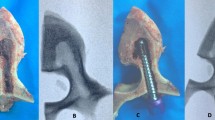Abstract
Biomechanical studies have shown hooks to be superior to pedicle screws in pull-out, especially in osteoporosis. This study evaluates the possible increase in stiffness of pedicle screws provided by laminar hooks while applying non-destructive forces to a vertebrectomy model assembled with Compact Cotrel Dubousset (CCD) instrumentation. Synthetic vertebrae were employed in a three-level vertebrectomy model. CCD screw-based three-level constructs with and without sublaminar hooks in the caudal element were tested in flexion, extension, compression, lateral bending, and torsion. There was no statistically significant advantage in adding inferior laminar hooks to a caudal end vertebra that had bilateral pedicle screws in any of the testing modes. Torsional stability, however, was augmented, but not significantly. Torsional instability and osteoporotic bone may be the clinical justifications for adding laminar hooks below screws in the caudal end vertebra.
Similar content being viewed by others
References
ASTM (1994) Provisional standard test method for static and dynamic spinal implants assembly in a corpectomy model. In: Annual book of ASTM standards. American Society for Testing and Materials, Philadelphia
Ashman RB, Galpin RD, Corin JD, Johnston CE (1989) Biomechanical analysis of pedicle screw instrumentation systems in a corpectomy model. Spine 14:1398–1405
Carl AL, Tromanhauser SG, Roger DJ (1992) Pedicle instrumentation for thoracolumbar burst fractures and fracture dislocations. Spine 17 [Suppl]: 317–324
Chopin D, Morin C (1991) Cotrel Dubousset instrumentation for adolescent idiopathic scoliosis. In: Bridwell KH (ed) Textbook of spinal surgery. Lippincott, Philadelphia
Coe JD, Warden KE, Herzig MA, McAfee PC (1990) Influence of bone mineral density on the fixation of thoracolumbar implants. A comparative study of transpedicular screws, laminar hooks and spinous process wires. Spine 15:902–907
Cunnigham BW, Sefter JC, Shono YS, McAfee MD (1993) Static and cyclical biomechanical analysis of pedicle screw spinal constructs. Spine 18: 1677–1688
Ebelke DK, Asher MA, Neff JR, Kraker DP (1991) Survivorship analysis of VSP spine instrumentation in the treatment of thoracolumbar and lumbar
Engler GL (1990) Cotrel-Dubousset instrumentation for reduction of fracture dislocations of the spine. J Spinal Disord 3:62–66
Esses SI, Sachs BL, Dreyzin V (1993) Complications associated with the technique of pedicle screw fixation. A selected survey of ABS members. Spine 18:2238–2239
Farcy JP, Weidenbaum M, Michelsen CB, Hoeltzel DA, Athanasiou K (1987) Comparative biomechanical study of spinal fixation using Cotrel-Dubousset instrumentation. Spine 12:877–881
Kramer DL, Rodgers WB, Mansfield FL (1995) Transpedicular instrumentation and short-segment fusion of thoracolumbar fractures: a prospective study using a single instrumentation system. J Orthop Trauma 9:499–506
McBride GG (1993) Cotrel-Dubousset rods in surgical stabilization of spinal fractures. Spine 18:466–473
McLain RF, Sparling E, Benson DR (1993) Early failure of short-segment pedicle instrumentation for thoracolumbar fractures. J Bone Joint Surg Am 75:162–167
Moreland DB, Egnatchik JG, Bennett GJ (1990) Cotrel-Dubousset Instrumentation for the treatment of thoracolumbar fractures. Neurosurgery 27:69–73
Stephens GC, Devito DP, McNamara MJ, Spengler DM (1993) Short segment transpedicular Cotrel-Dubousset instrumentation: a porcine corpectomy model. J Spinal Disord 6:252–255
Weidenbaum M, Farcy JC (1991) Surgical management of thoracic and lumbar burst fractures. In: Bridwell KH (ed) Textbook of spinal surgery. Lippincott, Philadelphia
Yoganandan N, Pintar F, Maiman DJ, Reinartz J, Sances A, Larson SJ, Cusick JF (1993) Kinematics of the lumbar spine following pedicle screw plate fixation. Spine 18:504–512
Zdeblick TA, Kunz DN, Cooke ME, McCabe R (1993) Pedicle screw pullout strength. Spine 18: 1673–1676
Author information
Authors and Affiliations
Corresponding author
Rights and permissions
About this article
Cite this article
Margulies, J.Y., Casar, R.S., Caruso, S.A. et al. The mechanical role of laminar hook protection of pedicle screws at the caudal end vertebra. Eur Spine J 6, 245–248 (1997). https://doi.org/10.1007/BF01322446
Received:
Revised:
Accepted:
Issue Date:
DOI: https://doi.org/10.1007/BF01322446




